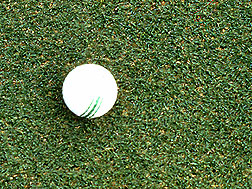Washington, DC, USA
June 21, 2012
 When a patch of unwanted grass discolors a putting green, it can cause headaches for golf course managers and for the sod farmers who supply them. But a U.S. Department of Agriculture (USDA) scientist has developed a tool to help minimize the damage.
When a patch of unwanted grass discolors a putting green, it can cause headaches for golf course managers and for the sod farmers who supply them. But a U.S. Department of Agriculture (USDA) scientist has developed a tool to help minimize the damage.
Putting greens in the southern United States are made up of single cultivars of bermudagrass, and the appearance of non-uniform plants, or "off-types," can throw off the green's appearance and "playability." Karen Harris-Shultz, a geneticist with the Agricultural Research Service (ARS) Crop Genetics and Breeding Research Unit in Tifton, Ga., has refined the process for telling one type of bermudagrass from another. This will help identify the source of unwanted off-types. ARS is USDA's principal intramural scientific research agency.
The lines of bermudagrass used on putting greens throughout the southeastern United States are all offshoots of Tifgreen, a variety developed more than 40 years ago by the late Glenn Burton, a former ARS grass breeder in Tifton. Even with the best molecular tools, the grass varieties are so nearly alike that it is sometimes hard to tell them apart.
When they find an off-type, golf course managers and sod farm managers often send samples of them to Harris-Shultz for analysis before deciding how to proceed. They need to know if the off-types are caused by a previously planted cultivar, a bermudagrass weed or by a mutation of the variety they planted.
Harris-Shultz collected 15 Tifgreen-derived cultivars from golf courses and research partners, extracted DNA from them and, with the help of an existing DNA database, developed a tool to help distinguish bermudagrass cultivars and identify contaminants.
The results, published in the Journal of the American Society of Horticultural Sciences, identify "repeatable polymorphic fragments" of DNA that are unique for each cultivar and can be used not only to distinguish among the different grasses, but to trace relationships between them.
Read more about the research in the May/June 2012 issue of Agricultural Research magazine.
Photo: The newer TifEagle bermudagrass over-seeded with Poa trivialis, mowed at 0.125 inch at a Savannah, Georgia, golf course. Photo by Wayne Hanna.
Manteniendo el verde de los campos de golf
Cuando un trozo de césped no deseado descolora un 'putting green' (un área del campo de golf especialmente dedicado a la práctica del putt), éste puede causar problemas para los gerentes del campo de golf y para los agricultores que proveen el césped al campo.
Ahora una científica del Servicio de Investigación Agrícola (ARS) ha desarrollado una herramienta para minimizar el daño. ARS es la agencia principal de investigaciones científicas del Departamento de Agricultura de EE.UU. (USDA por sus siglas en inglés).
Típicamente los campos de práctica del putt en la parte sureña de EE.UU. tienen un solo tipo del césped Bermuda, y el surgimiento de otras plantas no uniformes, llamadas en inglés 'off-types', puede afectar negativamente la apariencia y la "playabilidad" del campo. Karen Harris-Shultz, quien es genetista con la Unidad de Investigación de la Genética y la Crianza de Cultivos mantenida por el ARS en Tifton, Georgia, ha mejorado el proceso de distinguir entre diferentes tipos del césped Bermuda. Este adelanto ayudará a identificar la fuente de los tipos de césped no deseados.
Las líneas de césped Bermuda usadas en los campos de práctica del putt en todas partes del sudeste de EE.UU. están relacionadas con 'Tifgreen', la cual es una variedad desarrollada más de hace 40 años por el difunto Glenn Burton, quien era un criador de nuevas variedades de césped con el ARS en Tifton. Debido a las semejanzas de las variedades, algunas veces es difícil distinguir entre ellas, aún con las herramientas moleculares más avanzadas.
Cuando los gerentes de campos de golf o los productores de césped encuentran una planta no uniforme, ellos a menudo envían muestras a Harris-Shultz para análisis antes de tomar una decisión sobre un plan de acción. Ellos necesitan saber si la planta no uniforme es un vestigio de una variedad sembrada hace muchos años, es una maleza, o es una mutación de la variedad recién sembrada.
Harris-Shultz coleccionó 15 variedades relacionadas con 'Tifgreen' de 15 campos de golf y de socios de investigación, extrajo el ADN de las plantas, y con la ayuda de una existente base de datos de ADN, desarrolló una herramienta para ayudar a distinguir entre las variedades de césped Bermuda e identificar contaminantes.
Los resultados, publicados en 'Journal of the American Society of Horticultural Sciences' (Revista de la Sociedad Americana de Ciencias Hortícolas), identificaron fragmentos polimórficos repetibles de ADN que son únicos para cada variedad y que pueden ser usados no sólo para distinguir entre los diferentes céspedes, pero sino también para seguir la pista de su conexión.
Lea más sobre esta investigación en la revista 'Agricultural Research' de mayo/junio del 2012.